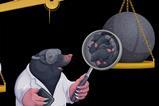A visualiser is a powerful, but often overlooked, teaching tool. Dust yours off and use it for these six topics

How many of you go whole days without turning on the visualiser lurking on the front bench? It’s easy to fall into habits and routines when we teach, and you may think, ‘I have a PowerPoint I use for this topic,’ or ‘I always do this demo for that concept’. But if you dust off your visualiser, you can use it throughout your lessons to spark students’ interest, enhance their memories and deepen their understanding.
In the starter
Zooming in on a phenomenon and displaying it on the big screen is a great way to get students’ chemical imaginations firing from the first moment of the lesson. You can start in a calm and organised way, with students in their seats looking to the front and quickly coming up with, and evaluating, possible explanations. Here are three topics and approaches to try:
Particle theory – Place the visualiser above petri dishes, one containing hot water, one cold, and add a drop of food colouring to one side of each. Ask the students to offer explanations for why the colour spreads out at different rates.
Ionic bonding – Put NaCl crystals on a sheet of black paper and hold them close to the visualiser, in focus as much as possible. Ask students to comment on their shape and come up with explanations in terms of the arrangement of ions. This can be extended in the main section of the lesson by drawing the crystal structure alongside to show the relationship.
Equilibrium – Place a yellow/green solution of copper chloride into a beaker of ice and observe the colour change. Students can see that no reagent is being added, but that a chemical reaction is occurring and can hypothesise about how this might work.
In the main
Visualisers can also enhance students’ experience of microscale chemistry. This doesn’t mean that they watch the reactions on the visualiser instead of doing it themselves, but that you can model how to make good observations, drawing on students’ own observations during their practical. Projecting the experiment onto the whiteboard also means the reaction can be labelled directly using dual coding to improve students’ capacity to grasp and recall the underlying chemistry. Ben Rogers’ article on using images in lessons might also be useful for this.
Displacement reactions of group 7 – Each dimple on the dropping tile can be labelled with the colour change and chemical reaction taking place.
Making salts – Precipitation of lead iodide in a petri dish. Add a crystal of KI (aq) on one side and a crystal of Pb(NO3)2 on the other. Students can observe the formation of the yellow PbI2 precipitate, and label the physical (dissolving and diffusion) and chemical (precipitation) changes occurring.
Electrolysis – Angle the visualiser side-on to the electrolysis of copper chloride solution. Show the formation of copper on the cathode and bubbles at the anode, and test with damp red litmus. Model how to draw the electrolysis set-up scientifically next to the live experiment, annotating the changes occurring at the anode, cathode and in the solution.
Repeat with a different example, and ask students to help with scientific drawing and labelling on the board.
In the plenary
At the end of the lesson, visualisers can also open the door to new ways of reviewing students’ work. For example, after completing an exam question, the visualiser allows you to model exam marking. By choosing an example (or making one up), you can show students how to identify the key phrases in the answer, underline or highlight marking criteria, and annotate the answer with missing information. These skills come naturally to teachers, but students need to see marking-up in action to learn how to do it effectively themselves. This boosts their ability to target marking criteria in their next exam practice.
Alternatively, at the end of a task individuals or small groups can place their work underneath the visualiser, and talk through how they did it. This might be explaining how they balanced a tricky equation, demonstrating their drawing and labelling of the experiment, or breaking down the parts of a multistep problem, such as a mole calculation or an organic synthesis. This kind of metacognitive thinking is critical for deep learning. It also allows other students to hear an alternative explanation from a peer, which helps if they did not fully understand the first time.














2 readers' comments